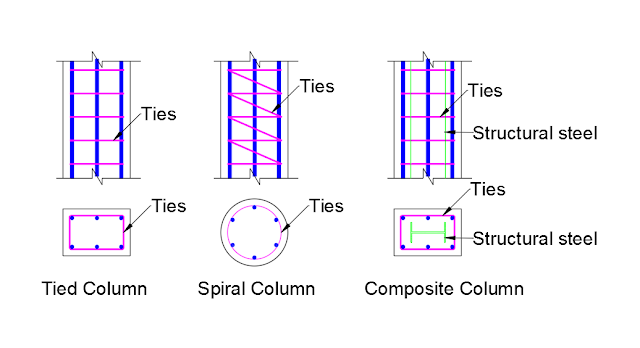Classification of columns
Types of columns & their properties
Structural Concrete member in compression are generally
termed as columns & strut. The term column is used for structural member
transferring loads to the ground. As per Indian Standard Code IS 456:2000
clause 25.1.1 defines the column as a compression member whose effective length
exceeds three times the least lateral dimension. Whereas pedestal is termed as
vertical compression members whose effective length is less than three times
its least lateral dimension.
Axially loaded columns may fail in any one of the following modes:
- Pure Compression failure- Where the column generally fails due to the axial load & Buldge at the center of the unsupported length.
- Combined Compression & bending failure- Where the column generally fails due to the combined effect of axial load & bending due to the presence of beams.
- Failure by elastic instability.
These modes generally depend on the slenderness ratio of the
column which in turns depend upon the cross-sectional dimensions, effective
length & support conditions of the column.
| Classification of Columns |
Classification of columns:
Based on type of reinforcement:
- Tied Column- In this type of columns the main longitudinal reinforcements are enclosed within closely spaced lateral ties. Tied columns are generally used in square, rectangle, T-shaped, L-shaped, circular columns etc.
- Spiral Columns- In this type of columns the main longitudinal reinforcements are also enclosed within closely spaced ties, but the ties are continuously wounded spiral reinforcement. Spiral columns are generally used in Circular columns & sometimes for square or octagonal sections.
- Composite Columns- In this type of columns the longitudinal reinforcement is in the form of structural steel section (such as ISMB, ISMC or steel pipes) with or without longitudinal reinforcements. It is generally used where the limit of providing Ast is reached, & no longitudinal bars can be accommodated to fulfil design requirement.
 |
| Types of columns |
Based on type of loading:
- Axially loaded column- Columns which experiences axial load symmetrically on all four sides are termed as axially loaded column. Internal columns of multi-storeyed building with symmetrical loads from slabs from all sides is an example of axially loaded column.
- Uniaxial eccentrically loaded column- Columns which experiences eccentric (the point of application of a load is away from the centroidal axis of the column) load on one side of the column is termed as uniaxial eccentrically loaded column. Columns with beam connected at one side is an example of Uniaxial eccentrically loaded column.
- Biaxial eccentrically loaded column- Columns which experiences eccentric load on two sides of the column is termed as biaxial eccentrically loaded column. Corner columns with beam connected at two side is an example of Biaxial eccentrically loaded column.
Based on Slenderness Ratio:
Depending
upon the slenderness ratio, which is Effective length / Least lateral dimension
columns can be termed as Short columns or Slender / Long column.
According to IS 456:2000 code clause 25.1.2, when both the
slenderness ratio’s (Lex / D) & (Ley / b) are less
than 12 it is termed as short column. If the ratio is equal to or more than 12
then it is termed as Slender / Long column.
Where,
Lex = Effective length in respect of major axis.
D
= Depth in respect of major axis.
Ley
= Effective length in respect of minor axis.
b
= Width of the member.
In case
of Non-rectangular & non circular sections where the slenderness ratio is
better defined in terms of radius of gyration rather than the lateral
dimensions these definition of Short or long column is not applicable.


Comments
Post a Comment